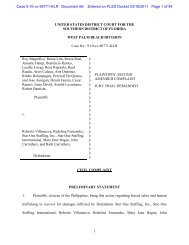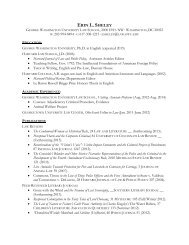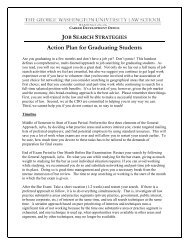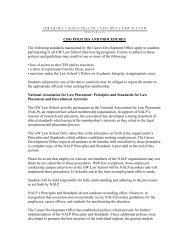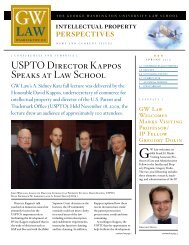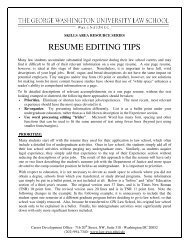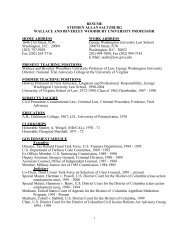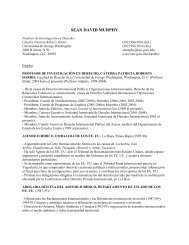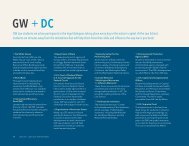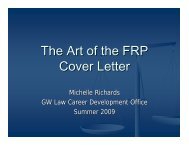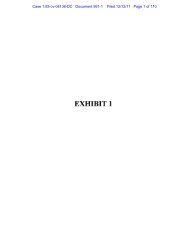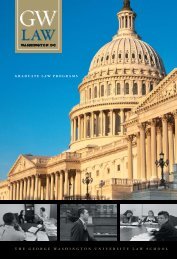CLE Materials for Panel #1 - George Washington University Law ...
CLE Materials for Panel #1 - George Washington University Law ...
CLE Materials for Panel #1 - George Washington University Law ...
Create successful ePaper yourself
Turn your PDF publications into a flip-book with our unique Google optimized e-Paper software.
WILMARTH<br />
4/1/2011 1:11 PM<br />
2011] The Dodd-Frank Act 997<br />
debt claims or an exchange of substantial portions of their debt claims<br />
<strong>for</strong> equity in a successor institution. I would have required the FDIC<br />
to prepare an SRD and to comply with the SRD Review Procedure if<br />
the FDIC proposed to depart from any of those principles based on<br />
systemic risk considerations. 187<br />
Dodd-Frank incorporates the first two of my core principles. It<br />
requires the FDIC to ensure that equity owners of a failed SIFI do not<br />
receive any payment until all creditor claims are paid and that the<br />
managers responsible <strong>for</strong> the failure are removed. 188 At first glance,<br />
Dodd-Frank seems to embody the third principle by directing the<br />
FDIC to impose losses on unsecured creditors if the assets of the SIFI<br />
are insufficient to pay all secured and unsecured debts. 189 However, a<br />
careful reading of the statute reveals that Dodd-Frank authorizes the<br />
FDIC to provide full protection to favored classes of unsecured<br />
creditors of failed SIFIs.<br />
In its capacity as receiver <strong>for</strong> a failed SIFI, the FDIC may provide<br />
funds <strong>for</strong> the payment or transfer of creditors’ claims in at least two<br />
ways. First, the FDIC may provide funding directly to the SIFI’s<br />
receivership estate by making loans, purchasing or guaranteeing<br />
assets, or assuming or guaranteeing liabilities. 190 Second, the FDIC<br />
may provide funding to establish a “bridge financial company”<br />
(BFC), and the FDIC may then approve a transfer of designated assets<br />
and liabilities from the failed SIFI to the BFC. 191 In either case, the<br />
FDIC may (1) take steps to “mitigate[] the potential <strong>for</strong> serious<br />
adverse effects to the financial system” 192 and (2) provide preferential<br />
treatment to certain creditors if the FDIC determines that such<br />
treatment is necessary to “maximize” the value of a failed SIFI’s<br />
assets or to preserve “essential” operations of the SIFI or a successor<br />
187 Wilmarth, supra note 6, at 756–57, 752 (arguing that the FDIC should be required to<br />
show that a departure from the core principles was “necessary in order to avoid a<br />
substantial threat of severe systemic injury to the banking system, the financial markets, or<br />
the national economy” in order to satisfy the prerequisites <strong>for</strong> an SRD).<br />
188 Dodd-Frank Act §§ 204(a)(1), (2), 206(2), (4).<br />
189 §§ 204(a)(1), 206(3).<br />
190 § 204(d). The FDIC may not acquire any equity interest in a failed SIFI or any<br />
subsidiary thereof. § 206(6).<br />
191 Id. § 210(h)(1), (3), (5). A BFC may not accept a transfer of any claims that are<br />
based on equity ownership interests in a failed SIFI. § 210(h)(3)(B).<br />
192 Id. § 210(a)(9)(E)(iii); see also id. § 206(1) (requiring the FDIC to determine that its<br />
actions as receiver are “necessary <strong>for</strong> purposes of the financial stability of the United<br />
States, and not <strong>for</strong> the purpose of preserving the [failed SIFI]”).




